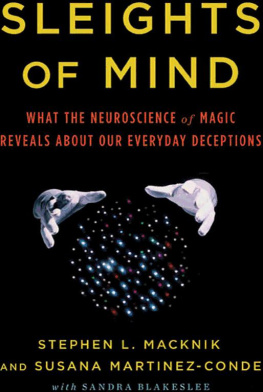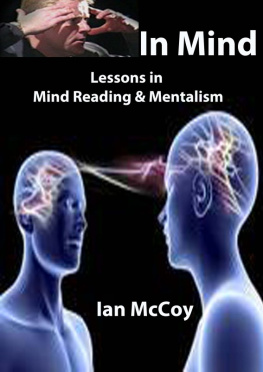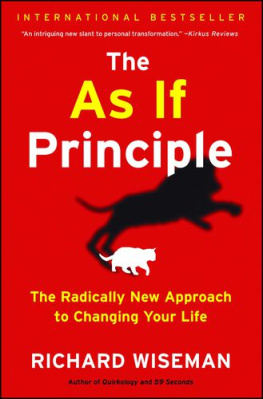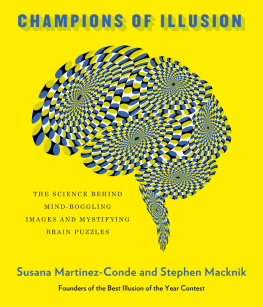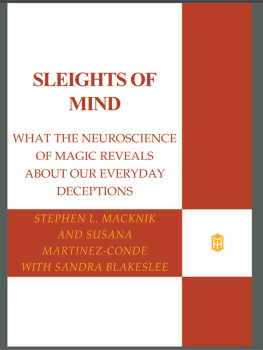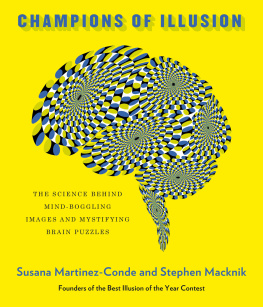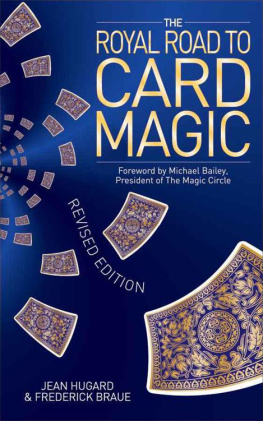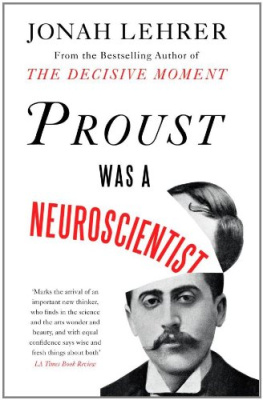1. The Woman in the Chameleon Dress:
Visual Illusions and Magic
2. The Secret of the Bending Spoon:
Why Magicians Watch Their Angles
3. The Brother Who Faked a Dome:
Visual Illusions in Art and Science
4. Welcome to the Show but Please Leave On Your Blinders:
Cognitive Illusions
5. The Gorilla in Your Midst:
More Cognitive Illusions
6. The Ventriloquists Secret:
Multisensory Illusions
7. The Indian Rope Trick:
Memory Illusions
8. Expectation and Assumption:
How Magicians Make ASSes of U and ME
9. May the Force Be with You:
The Illusion of Choice
10. Why Magic Wands Work:
Illusory Correlations, Superstition, Hypnosis, and Flimflam
C LARKES T HIRD L AW : Any sufficiently advanced technology is indistinguishable from magic.
N IVENS L AW : Any sufficiently advanced magic is indistinguishable from technology.
A GATHA H ETERODYNE (G IRL G ENIUS ) P ARAPHRASE OF N IVENS L AW: Any sufficiently analyzed magic is indistinguishable from science!
Have you ever wondered how magic effects work? Coins materialize out of thin air. Cards move through a deck as if pulled by an invisible force. Beautiful women are cut in half. Spoons bend. Fish, elephants, even the Statue of Liberty disappear before your eyes. How does a mentalist actually read your mind? How can you not see the gorilla in the room? Really, how can someone catch a bullet in his teeth? How do they do it?
Dont bother to ask a conjurer. When joining an organization of professional magicians, the initiate may be asked to take an oath: As a magician I promise never to reveal the secret of any illusion to a nonmagician, unless that person also swears to uphold the magicians oath. I promise never to perform any illusion for any nonmagician without first practicing the effect until I can do it well enough to maintain the illusion of magic. It is a code. A brotherhood. The magician who breaks this code risks being blackballed by his fellow magicians.
So what are we, a couple of muggles, doing writing a book on magic? Zipped lips aside, hasnt most everything about magic been revealed? Enter magic in the Amazon Books search box and 75,000 results pop up. Log in to YouTube and you can see just about every magic trick ever devisedoften demonstrated by darling seven-year-olds in their bedrooms with Mom or Dad wielding the videocam. Visit Craigslist and choose from myriad charming descriptions of local amateur magicians. Whats left to say?
Actually, plenty. This is the first book ever written on the neuroscience of magic, or, if you will, neuromagic , a term we coined as we began our travels in the world of magic. Much has been said about the history of magic, tricks of the trade, the latest props, and psychological responses to magical effects. But neuroscience probes more deeply. We want to pop the hood on your brain as you are suckered in by sleights of hand. We want to explain at a fundamental level why you are so thoroughly vulnerable to sleights of mind. We want you to see how deception is part and parcel of being human. That we deceive each other all the time. And that we survive better and use fewer brain resources while doing so because of the way our brains produce attention.
Like so much that happens in science, we fell into magic by accident. We are neuroscientists at the Barrow Neurological Institute in Phoenix, Arizona. The BNI is the oldest stand-alone neurological institute in the United States and currently the largest neurosurgical service in North America, performing more than six thousand craniotomies per year. Each of us runs a research laboratory in the institute. Stephen is director of the laboratory of behavioral neurophysiology. Susana is director of the laboratory of visual neuroscience. Incidentally, we are married. Both of us are primarily interested in how the brain, as a device that is made up of individual cells called neurons, can produce awareness, the feeling of our first-person experience. Somehow, when neurons are hooked up to each other in specific circuits, awareness is achieved. Its the ultimate scientific question, and neuroscience is on the verge of answering it.
Our foray into illusions began a decade ago when, as young scientists seeking to make a name for ourselves, we tried to rustle up some public enthusiasm for our specialty of visual neuroscience. In 2005, after accepting faculty appointments at BNI, we organized the annual meeting of the European Conference on Visual Perception, which was held in Susanas hometown of A Corua, Spain. We wanted to showcase visual science in a new way that would intrigue the public and the media. We were fascinated with how science can explain something about the visual artsfor example, Margaret Livingstones work on why the Mona Lisas smile is so ineffably enigmatic. We also knew that visual illusions are fundamentally important to understanding how the brain turns raw visual information into perception.
The idea we came up with was simple: we would create the Best Illusion of the Year contest. We asked the scientific and artistic communities to contribute new visual illusions and received more than seventy entries. The audience (a mixture of scientists, artists, and the public) viewed the ten best illusions and then chose the top three. The contest, now in its seventh year, has been a huge success. Our Internet audience doubles every year, and our Web site ( http://illusionoftheyear.com ) currently has about 5 million page views each year.
Because of our success with the illusion contest, the Association for the Scientific Study of Consciousness asked us to chair its 2007 annual conference. The ASSC is a society of neuroscientists, psychologists, and philosophers united in the aim to understand how conscious experience emerges from the interactions of mindless, individually nonconscious brain cells.
As our opening move, we proposed holding the conference in our hometown of Phoenix, but the associations board nixed that right away because the city is an inferno midyear. Instead, they suggestedLas Vegas. Hmmm. Las Vegas is every bit as blisteringly hot in June as Phoenix, and if you take the lap dancing, gambling, and showgirls into account it is probably several degrees hotter due to friction. So apparently our colleagues in consciousness studies were looking for a bit of real excitement to spice up their thought experiments.
So Vegas it was. We flew there in October 2005 to do some scouting. On the flight over we asked ourselves: How could we raise the visibility of consciousness research to the public? We didnt want to do another contest. The answer began to germinate the moment our plane dipped its wings on approach to the Las Vegas airport. Out the window we could see, all at once, the Statue of Liberty, the Eiffel Tower, an erupting volcano, the Space Needle, the Sphinx, Camelot, and the Great Pyramid. Soon we were driving up and down the Strip, checking out hotels for our meeting space. We passed Aladdins castle, the Grand Canal of Venice, and Treasure Island. It seemed too strange to be real. Then, bingo: the theme for our conference appeared. Festooned on billboards, taxicabs, and buses were huge images of magicians: Penn & Teller, Criss Angel, Mac King, Lance Burton, David Copperfield. They stared out at us with mischievous eyes and beguiling smiles. And then it hit us that these tricksters were like scientists from Bizarro Worlddoppelgngers who had outpaced us real scientists in their understanding of attention and awareness and had flippantly applied it to the arts of entertainment, pickpocketing, mentalism, and bamboozlement (as well as to unique and unsettling patterns of facial hair).

